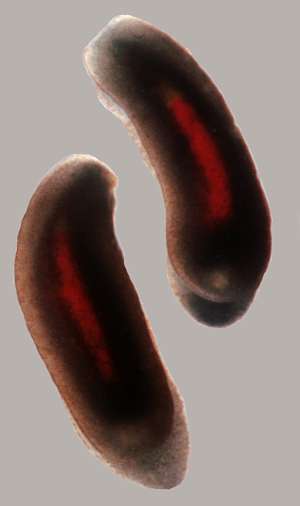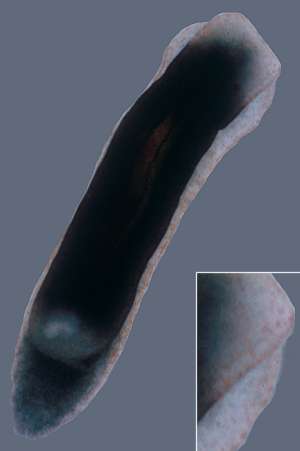

Runnica katipoides
Miller & Rudman, 1968
Order: CEPHALASPIDEA
Superfamily: RUNCINOIDEA
Family: Runcinidae
DISTRIBUTION
New Zealand
PHOTO
Upper photo: On Corallina algae growing on rocks at low water. High Island, near McGregor's Bay, Whangarei Heads. NE New Zealand. May 1963. [Holotype & Paratype]. Lower Photo: Outside of middle archway Tawhiti Rahi Island. Poor Knights Ids. 22 March 1972. NE New Zealand. Photos: M.C. Miller [digitally enhanced by WBR]
The body is long and narrow when extended, being widest and highest at the posterior end of the notum and tapering gradually to the low and weakly bilobed head. The foot extends posteriorly beyond the notum forming a tail which may be up to a fifth of the total length. Eyes situated at the side of the head below the notal fold, sometimes visible through the notum in lightly pigmented animals. There is a single pinnate gill, with up to five upper and four lower pinnae, lying immediately to the right of the mid-line below the posterior flap of the notum. The anus is situated in the mid-line at the left of the base of the gill; the renal pore lying below the gill. The common genital aperture is to the right and below the level of the gill; and from this opening a ciliated groove runs along the right side of the body to the penis which lies retracted just to the right side of the mouth.
The animal is dark-grey, almost black, with a lanceolate, clear, central area, often flanked by a pair of black lines. The bright red digestive gland is often visible through the posterior half of the mid-dorsal clear area. There is a roughly ovate clear area at the rear end of the notum and in the centre of this the interanl shell can be seen as a prominent opaque white spot. The upper surface of the body is speckled evenly with reddish-brown pigment [see inset in lower photo], but this is often obscured by the black pigmentation. The sole of the foot dark grey to black.
There are 4 chitinous plates, and the radula formula is 1.1.1. The animal is herbivorous and grows to approximately 6 mm in length, but seldom grows beyond 4 mm. It is often common intertidally in algal turf. The species is named after the katipo, a coastal New Zealand spider (related to the Australian Redback and the Nth American Black Widow spiders), which is also black with a longitudinal red stripe.
-
Miller, M.C. & Rudman, W.B. (1968) Two new genera and species of the superfamily Runcinoidea (Mollusca Gastropoda: Opisthobranchia) from New Zealand. Transactions of the Royal Society of New Zealand, 10(19): 183-189.
-
Rudman, W.B. (1971) Structure and functioning of the gut in the Bullomorpha (Opisthobranchia) Part 1. Herbivores. Journal of Natural History 5(6): 647-675, 18 figs.
Rudman, W.B., 2005 (February 9) Runnica katipoides Miller & Rudman, 1968. [In] Sea Slug Forum. Australian Museum, Sydney. Available from http://www.seaslugforum.net/factsheet/runnkati
